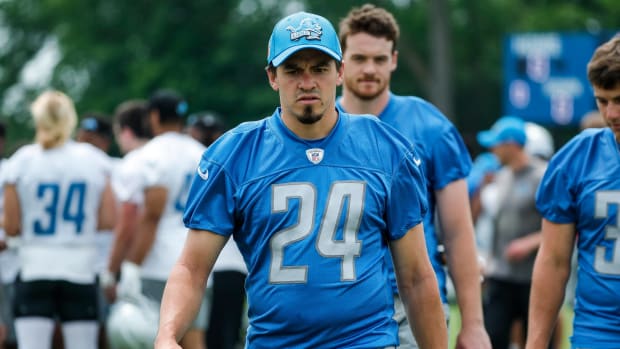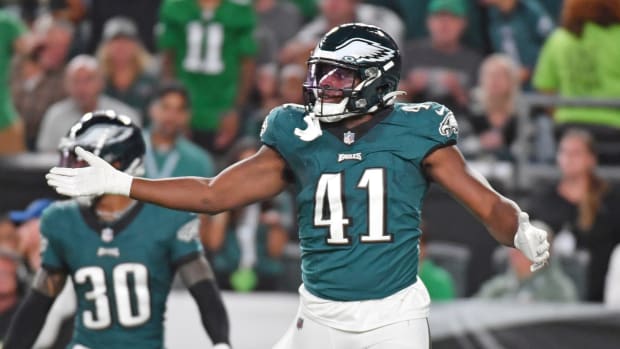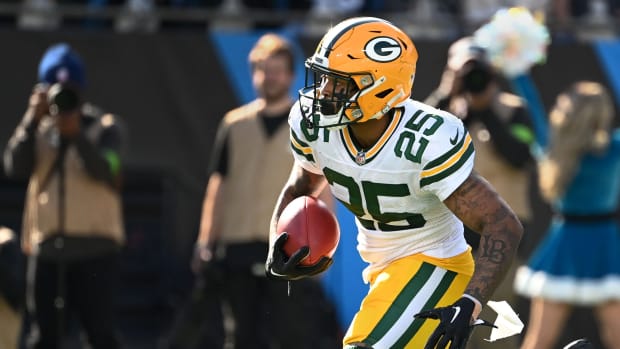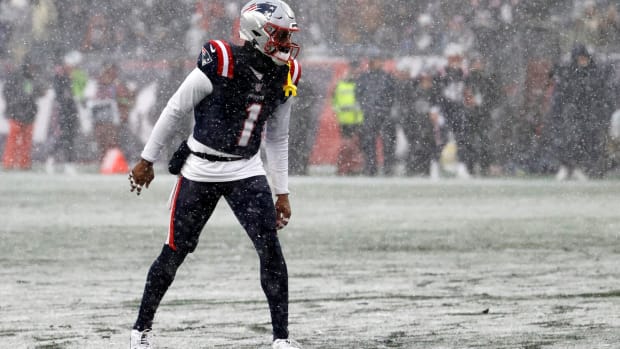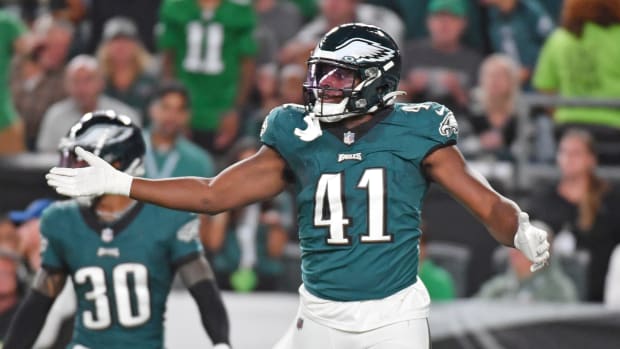Olson addition to Brady’s team means Deflategate ruling far from over
Get all of Michael McCann's columns as soon as they’re published. Download the new Sports Illustrated app (iOS or Android) and personalize your experience by following your favorite teams and SI writers.
The odds that Jimmy Garoppolo will be the starting quarterback for the New England Patriots to open the 2016 regular season against the Arizona Cardinals just dropped a bit thanks to a 75-year-old attorney from Washington, D.C.
On Friday, Tom Brady and the NFLPA filed a notice of appearance with the U.S. Court of Appeals for the Second Circuit in order to announce that legendary appellate attorney Theodore “Ted” Olson has joined the legal team. Olson, the U.S. Solicitor General from 2001 to ’04, is best known for successfully arguing before the U.S. Supreme Court on behalf of Texas governor George W. Bush in George W. Bush v. Albert Gore, the case that resolved the contested 2000 presidential election. Olson has other momentous legal wins on his record, including Hollingsworth v. Perry, a case that overturned California’s “Proposition 8” ban on same-sex marriages. According to his law firm biography, Olson has argued 62 cases in the U.S. Supreme Court and won 75% of those arguments. If he were an NFL player, he would be a perennial MVP.
Tom Brady faces long odds after NFL wins Deflategate appeal
As with all elite attorneys with decades of experience, Olson has not won every case. One notable defeat occurred in 2011 when Olson unsuccessfully represented Brady and other players who sued the NFL over the lockout. Paul Clement, who has argued on behalf of the NFL in the current appeal involving Brady, argued on behalf of the NFL in 2011. Clement beat Olson in the case, which was heard by the U.S. Court of Appeals for the Eighth Circuit.
To be clear, the lockout litigation and the Deflategate litigation are mostly dissimilar cases and they implicate different areas of law: while the 2011 case centered on the Norris-La Guardia Act (which addresses injunctions during labor disputes) the 2015–16 case centers on the Labor Management Relations Act (which, among other things, addresses procedures for the relationship between unionized workers and management). Nonetheless, Olson might view joining Brady and the NFLPA as an opportunity to even the score with Clement, who like Olson is a former U.S. Solicitor General.
Olson’s impact
The main significance of Olson joining Brady’s legal team is that it increases the likelihood that the team will petition for a panel rehearing and a rehearing en banc. On Monday, Second Circuit Judges Barrington Parker Jr. and Denny Chin authored a majority opinion in which they reversed U.S. District Judge Richard Berman’s ruling in Brady’s favor. Chief Judge Robert Katzmann dissented (for more on the ruling, see my SI.com legal commentary). If Brady and the NFLPA intended to accept defeat, it is unlikely they would retain an attorney of Olson’s caliber, and it is equally unlikely that Olson would be interested in joining a legal team that is resigned to defeat.
Brady and the NFLPA on Friday also requested a 14-day extension to file a petition for a panel rehearing and a rehearing en banc. As of now, they have 14 days from April 25 to file these petitions; assuming the extension is granted (and such extensions typically are granted), they would then have 28 days from April 25. The request for extension is likely a sign that Olson wants time to revamp the NFLPA’s legal arguments, which to date have been advocated by attorney Jeffrey Kessler. Kessler, who scored a decisive victory before Judge Berman last fall, encountered skepticism from Judges Parker and Chin. I attended the March 3 oral arguments in New York City and it was clear from the get-go that Judges Parker and Chin were unconvinced by Kessler. Olson could reshape Brady’s existing arguments and formulate others, too. Olson likely wouldn’t agree to join the Brady/NFLPA legal team without the explicit assurance that his strategies would be incorporated into all future filings.
Potential legal fallout from Laremy Tunsil's hacked Twitter account
Assuming Brady and the NFLPA petition for a panel rehearing and a rehearing en banc, the petition for panel rehearing would almost certainly be rejected since it would be decided by the same three judges who just voted 2–1 for the NFL. A petition for a rehearing en banc, however, would be a different story. The decision as to whether to grant the rehearing en banc, which would consist of a new appeal hearing before the Second Circuit’s 13 active judges and Judge Parker (a senior status who would be eligible to sit on an en banc rehearing), would be made by the 13 active judges. In the Second Circuit, petitions for a rehearing en banc are only granted about 1% of the time, but the odds should be somewhat higher for Brady. For one, he lost in a split-decision, rather than in a shutout, and the dissenting judge is the court’s Chief Judge. It also stands to reason that some of the 13 active judges may view the legal dispute differently than Judges Parker and Chin. After all, when including Judge Berman, two federal judges have agreed with Brady’s perspective and two have agreed with the NFL’s perspective, meaning there is a clear divide of opinion as to which side is “right.”
The addition of Olson could be a game-changer in terms of whether a rehearing en banc is granted. The 13 judges who will decide whether to grant such a rehearing may be more deferential to Olson than they would to other attorneys. Olson is widely regarded as a brilliant attorney. His insights should enhance Brady’s legal arguments, thus making it more likely a rehearing would be granted. Prominent sports attorney Paul Kelly, a former NHLPA executive director and former Assistant U.S Attorney, told SI.com that Olson’s addition increases the odds of a rehearing en banc. “Now you have a battle of former Solicitor Generals, Olson v. Clement,” Kelly, a principal at Jackson Lewis in Boston, observed. “That has to spark interest in the judges. They are human and probably most are football fans.
If a rehearing is granted, it might not be scheduled until the fall, which would mean an indefinite delay in Brady serving a suspension. In that scenario, Brady’s suspension would be stayed (postponed) until his rehearing is decided. Even with Olson on his side, however, Brady’s odds for a rehearing being granted remain far under 50%. The granting of a rehearing also wouldn’t necessarily mean that Brady would win the rehearing.
What’s next for each side after the NFL’s concussion settlement
If a rehearing is neither granted nor proves successful, Brady would likely then petition the U.S. Supreme Court. Brady would again face long odds, as the Supreme Court only accepts about 1% of cases for review. Olson’s presence, however, should help. The Court’s justices are very familiar with Olson and Clement, and they have seen these two attorneys in action many times before. It is possible the justices might regard the Brady case as more important if it could attract the advocacy of Olson and Clement.
In conjunction with a petition to the U.S. Supreme Court, Brady would ask the Second Circuit to stay the imposition of the suspension until the Supreme Court has taken action, which might not be until 2017. To obtain a stay, Brady would need to demonstrate a high probability of success on the merits and so-called “irreparable harm.” Irreparable harm generally refers to harm that monetary compensation cannot cure. Brady would insist that he would suffer irreparable harm if the court denies a stay. More specifically, Brady would assert that once he serves the suspension, he can never get those games back. In response, the NFL would insist that Brady would not suffer irreparable harm because, should Brady ultimately prevail in court, he could eventually be repaid for salary lost as part of his suspension. Brady would reject such an argument by insisting that missing four games would irretrievably alter his team’s chances for success and thus Brady’s career.
Some might scoff at the idea that the Supreme Court should hear a case about a football player’s suspension and a bizarre equipment controversy. To be sure, even the most diehard football fans would agree that there are far more important topics facing the United States. Yet as sports litigator Alan Milstein, who has litigated against the NFL in the Second Circuit, told SI.com, the Supreme Court might view the Brady case as far more than about the air pressure of footballs. Milstein surmises that the broader issue of adequate due process in arbitration hearings—a fundamental concern for Brady, who contends he was denied sufficient notice and fairness—is one that has recurred in federal court decisions and is ripe for review by the Supreme Court. Also, as I noted earlier this week, the outcome of the Adrian Peterson appeal in the U.S. Court of Appeals for the Eighth Circuit might also increase the odds the Supreme Court would hear the Brady case. A decision on the Peterson case, oral arguments for which occurred 194 days ago, is expected any day now. Olson might cite it in petitions to the Second Circuit (another reason why the 14-day extension could prove meaningful) and the U.S. Supreme Court. We’ll see.
The bottom line: The addition of Olson to the Deflategate saga makes it more likely the saga won’t end anytime soon.
Michael McCann is a legal analyst and writer for Sports Illustrated. He is also a Massachusetts attorney and the founding director of the Sports and Entertainment Law Institute at the University of New Hampshire School of Law. He also created and teaches the Deflategate undergraduate course at UNH, serves as the distinguished visiting Hall of Fame Professor of Law at Mississippi College School of Law and is on the faculty of the Oregon Law Summer Sports Institute.
































